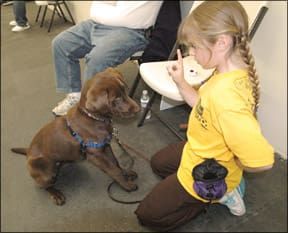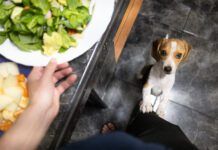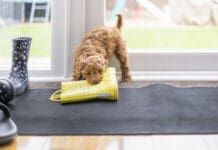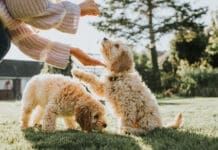[Updated November 16, 2017]
PUPPY TRAINING CLASS: OVERVIEW
1. Bring your “A” game to puppy class. Get a good night’s sleep before a morning class, get up early for coffee — whatever it takes!
2. Try not to get caught up in conversation with other puppy owners during class. You need to pay attention to the instructor — and your own puppy!
3. Practice daily at home, so you and your puppy have mastered each week’s material and are ready to learn new skills when you come to class.
You’ve got a new puppy and are about to start puppy classes (or are planning ahead for your new pup – even better!). You know good puppy classes are an integral part of helping you and your dog invest in a long and harmonious future. Congratulations!

Once you’ve selected a class that meets your needs (see “How to find the Best Dog Trainer for Your Dog,” for help selecting the right class for you and your dog) and you’ve signed up to ensure your place in class – you are all set, right? Wrong!
Puppy classes aren’t magic. Just signing up, paying, and attending aren’t enough. You have to train and practice and build your relationship with your puppy. It will last a lifetime and the effort you put in now will pay off multifold. But keep in mind that the bad habits that you and your puppy develop now will also give you payback many times over! So let’s assume you have really committed yourself to rearing a puppy well, and talk about how to get the most out of your puppy classes.
Paying Attention in Puppy Class
In today’s economy, most of us want to be sure we get the most bang for our bucks and that’s true for the cost of puppy classes. Carefully select your class in advance. Of course, we want you to find an experienced positive trainer. But you also need to find a class in a location that’s convenient enough and offered at a time of day to ensure that you’ll actually attend. If the class that you want is offered only at 7 pm on a weeknight or 8 am on Saturday morning, and you are usually tired at these times, you may have to look for another option – or plan to have an espresso early enough before class to get you there and keep you alert.
Alertness is critical in any educational setting. If you are too tired to be attentive to what the instructor is saying, or to cheerfully interact with your dog (who, thanks to the many distractions in class, may be at his worst), you won’t get as much out of the class as you could.
Does this sound easy? It’s not! It’s difficult to pay attention to two things at once (your puppy and the instructor) while surrounded by other cute and active puppies and their owners. And if you happen to be seated next to an especially gabby owner, or excitable puppy, it can be even more difficult. If you are talking to someone, you can’t properly hear the instructor or attend to your puppy. If you are watching your puppy play with another pup, you can’t pay attention to the instructor. You paid for the information being provided. Don’t waste these critical puppy-rearing moments (or your money) by failing to focus.
I don’t need to mention that mobile phones should never be present in class, do I?
At the same time that you are listening to the instructor and watching her demonstrations, it’s essential that you are also aware of what your pup is doing. These are golden opportunities for you to reinforce behaviors you like, such as looking calmly at the other pups and people in class, and especially, for “checking in” with you with eye contact. You may also have to distract your puppy and prevent her from practicing behaviors you don’t want, such as barking, whining, pulling on the leash to go visiting, chewing the leash, chewing on the mat, pawing at you, mugging you for treats, or mouthing you.
Treats are Your Greatest Tool for Cooperation
Speaking of treats, it’s vitally important that you bring an ample and varied supply to class. You don’t want to run out before the end of class, or to have to scrimp on reinforcement because you are afraid you are going to run out. It’s best if you have at least three or four types of treats in your bait bag; this keeps your puppy guessing what delicious treat might be next, and keeps him from getting tired of (and undermotivated by) any one type of treat.

Ideally, you should include treats of a varying level of interest to your puppy, too: treats he likes, treats he’s crazy about, and some treats he’d stand on his head for! Use the highest-value treats for rewarding the most difficult behaviors you ask your pup to perform, new behaviors, or for “easy” behaviors performed against a backdrop of distractions. You may have to try a lot of different types of treats at home in order to identify treats of these varying levels of “value” to your dog.
The treats you bring to class should also be tiny! – especially if you have a small dog. That’s because you’ll be feeding a lot of them in class, and you don’t want him to fill up too soon, so pre-cut those treats into pieces the size of a pea or smaller. It also helps to bring your pup in on an empty or near-empty stomach so if class is scheduled around your pup’s meal time, feed only half the usual meal and bring the balance as healthy, delectable treats for class. Consider using cut-up pieces of boiled lean chicken, turkey, beef, or pork.
You need to deliver those treats to your puppy quickly so you want the treats easily accessible to you. I suggest using a “bait bag” or treat pouch to keep the treats handy; there are lots of great ones on the market. Other good treat holders are fanny packs, carpenter aprons, and loose vest pockets. Ziploc bags are horrid! Just about as hard to use as jeans pockets.
Being a Good Puppy Class Student
In class, during practice times, PRACTICE! When the instructor comes around to see how you and your puppy are doing, make sure you take the opportunity to demonstrate the behavior you are supposed to be practicing at that moment. Generally, the instructor circulates to every dog/handler team and watches for a repetition or two, gives some feedback, and moves on. If you haven’t been able to get your pup to perform the behavior yet, don’t just say that; show the instructor how you’ve been going about it so she can see what’s wrong and show you a different way to do it. Everyone should get pretty equal time by the end of each class and no one should monopolize the instructor. So play fair!
Usually there are question periods during each class. Help use the class time well by preparing a priority question or two in advance. What are you most stuck on or confused about? Ask the question as concisely as possible. This is not the time for a long story about your pup’s adorable antics at home. Your classmates have also paid for class and it’s their time, too. Use it constructively. If your issue is something unique to your household or situation, ask if you can speak to the trainer about it before or after class or perhaps email or telephone for a brief discussion. Classes are for general topics and issues.

It’s helpful when your entire family participates in training the family dog, and when all of you use the same cues to elicit the various behaviors you learn in class. It follows, then, that it’s also helpful for the most interested family members to attend training class. That can include kids, but make sure you bring only those kids whose attention spans are long enough and behavior is good enough, so that they don’t disrupt the class. Or bring a second adult or responsible teen who can take the kids out of class as needed for breaks.
Practice What You Learn
I can’t stress this enough: Practice, practice, practice every single day!
Practice is rather like preparing the ground before transplanting a plant. It would be a shame to put a lovely purchased plant into soil that hasn’t been prepared in advance; it won’t be as successful as the plant that gets thoughtful fertilizing, watering, and of course is a good match for the soil and sun in the first place.
Between classes, it’s all up to you. Practice teaching your dog the behaviors you’ve learned in class many times a day – every day – in short, positive sessions. Puppies have short attention spans, so practice for a total of at least 15 to 45 minutes a day, in at least three sessions sprinkled throughout the day. Short and more-frequent sessions are better than fewer, longer ones; three 5- to 10-minute sessions provide better training than a single 15- to 30-minute session.
“Capture” and reward behaviors whenever you can. Is your puppy running to greet you? Super! Label it “Rover, come!” and reward her lavishly when she gets to you. Walking down the hallway with the puppy at your side? Label it “heel” (or whatever you’ll call nice, loose leash walking) and reward it! Keep working on your puppy’s name recognition, too, by brightly saying her name and rewarding her interest and attention with a delicious treat, a few moments of the kind of petting she likes best (belly rubs, neck massage, a nice scratching session at the top of her tail), and/or warm praise.
Use your everyday routines to remind you to practice with your puppy. Going to the end of the driveway to get the mail from the box? Bring your puppy on her leash.
That means an opportunity to sit nicely for attaching her leash and for opening the door. It also gives you the opportunity to reward her for reorienting (eye contact to you) after you’ve both stepped through the doorway. Then she gets to practice nice walking with you all the way to the mail box and back (with some cued sits, downs, eye contact, etc. along the way). When you get back to your door, you have another chance to have your puppy sit to await the cue to go through the door. And then she can offer a polite sit on the other side of the door before you let her free in the house again.
Wasn’t that a lovely little training session? Look at all the things it included as well as some nice exposure to a brief trip outdoors where the pup may have seen pedestrians, vehicles, birds, squirrels, airplanes overhead, etc. to give you a chance to reward her for calmly noticing things and turning her attention back to you. Playing with your dog in your fenced yard? Ask for some sits, downs, come, and some eye contact! Your dog’s reward might be a chance to chase a ball or chase you!
Most puppy training classes give the participants written homework to help them focus and remember. Use it. Don’t pull it out the night before class (or the hour before) and try to “cram” – that’s not how you’ll get the habits installed in your puppy. Practice every day in multiple short sessions.
If your puppy class doesn’t include everything you wished it did (and what class ever does?), read up on those other things and work on them yourself.
The class should teach you the principles of positive training with your puppy. Start applying them to behaviors beyond those taught in class! Puppies are like little sponges and learn so easily once we learn how to be clear with them and make it all fun.
Use your class time well and use your home time even more wisely. It’s an investment in your future with your dog. Unlike many of today’s investments, this is one almost guaranteed to bring rich returns for life.
The Value of Training in Everyday Life
Training starts the moment you bring your pup into your car to head home with you. How will your pup travel? Has the puppy ever been in a car before? How will you make this first car trip as safe and comfortable as possible?
Then there are all the rules the puppy has to learn about living with a human family in a human’s house: when and where it’s okay to potty, what furniture is off-limits, what a puppy is allowed to chew on and what she is forbidden to investigate with her mouth, how much and what times of day vocalizing is acceptable — it’s endless.
My point is this: Puppies are always learning. We consciously teach them what to do and what not to do only some of the time. In order to be as successful as possible in teaching your little pup to grow tip into a good canine citizen, you’ll need to make the most of every opportunity for your puppy to do the things you want him to do — and give him few or no opportunities to practice naughty behaviors. This means training whenever you can, and managing his environment carefully when you can’t be there to train.
Caryl-Rose Pofcher is a dog trainer based in Amherst, MA. As well as running her own dog training business, My Dog, LLC, she also trains for her local shelter, Dakin Pioneer Valley Humane Society, and for the Collared Scholar dog training center. See “Resources,” for contact information.






